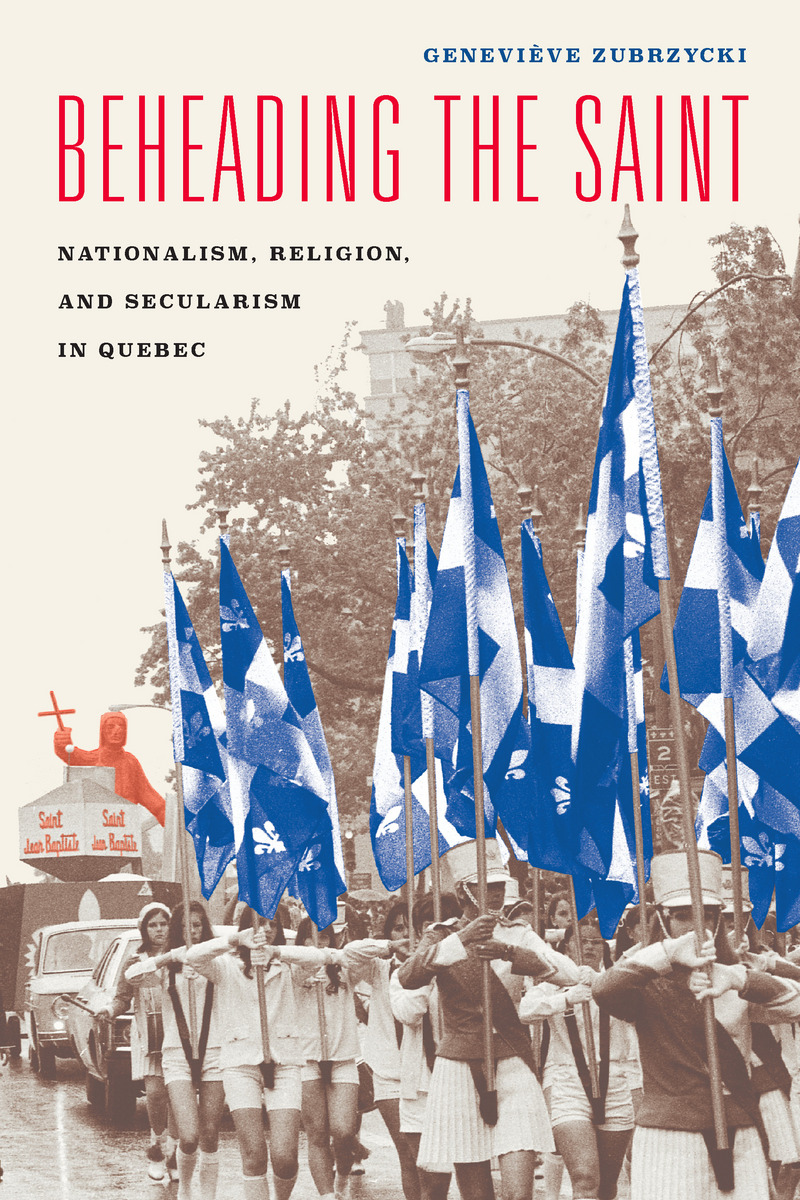Beheading the Saint
Nationalism, Religion, and Secularism in Quebec
University of Chicago Press, 2016
Cloth: 978-0-226-39154-0 | Paper: 978-0-226-39168-7 | Electronic: 978-0-226-39171-7
DOI: 10.7208/chicago/9780226391717.001.0001
Cloth: 978-0-226-39154-0 | Paper: 978-0-226-39168-7 | Electronic: 978-0-226-39171-7
DOI: 10.7208/chicago/9780226391717.001.0001
AVAILABLE FROM
University of Chicago Press (cloth, paper, ebook)Amazon Kindle
Apple Books
Barnes & Noble Nook
DeGruyter Multi-User Ebook Program
EBSCO eBooks (formerly NetLibrary)
Google Play
Kobo
OverDrive
University Press Scholarship Online (UPSO)
ABOUT THIS BOOKAUTHOR BIOGRAPHYREVIEWSTABLE OF CONTENTS
ABOUT THIS BOOK
Through much of its existence, Québec’s neighbors called it the “priest-ridden province.” Today, however, Québec society is staunchly secular, with a modern welfare state built on lay provision of social services—a transformation rooted in the “Quiet Revolution” of the 1960s.
In Beheading the Saint, Geneviève Zubrzycki studies that transformation through a close investigation of the annual Feast of St. John the Baptist of June 24. The celebrations of that national holiday, she shows, provided a venue for a public contesting of the dominant ethno-Catholic conception of French Canadian identity and, via the violent rejection of Catholic symbols, the articulation of a new, secular Québécois identity. From there, Zubrzycki extends her analysis to the present, looking at the role of Québécois identity in recent debates over immigration, the place of religious symbols in the public sphere, and the politics of cultural heritage—issues that also offer insight on similar debates elsewhere in the world.
In Beheading the Saint, Geneviève Zubrzycki studies that transformation through a close investigation of the annual Feast of St. John the Baptist of June 24. The celebrations of that national holiday, she shows, provided a venue for a public contesting of the dominant ethno-Catholic conception of French Canadian identity and, via the violent rejection of Catholic symbols, the articulation of a new, secular Québécois identity. From there, Zubrzycki extends her analysis to the present, looking at the role of Québécois identity in recent debates over immigration, the place of religious symbols in the public sphere, and the politics of cultural heritage—issues that also offer insight on similar debates elsewhere in the world.
AUTHOR BIOGRAPHY
Geneviève Zubrzycki is associate professor of sociology at the University of Michigan. She is the author of The Crosses of Auschwitz: Nationalism and Religion in Post-Communist Poland, also published by the University of Chicago Press.
REVIEWS
“Zubrzycki’s analysis is a tour de force and a real contribution to visual sociology and the history of material culture. She brilliantly unpacks the cultural and iconographic logics of the various visual symbols and argues convincingly that these iconographic struggles were not merely products of the political and cultural change taking place in Quebec society, but themselves important agents producing the change. Beheading the Saint is beautifully written, splendidly illustrated, based on extensive research, much of it archival, and extremely original. Its subject is one of the most interesting, but insufficiently well-known, social and political transformations of the past half-century. This is a superb book.”
— William H. Sewell, Jr., University of Chicago“Elaborating the ‘national sensorium’ through which French Canadians became Quebecois in the late twentieth century, Zubrzycki skillfully deploys the tools of sociological, historical, and visual analysis to reveal a new national identity in the making. Zubrzycki’s deep and detailed readings of holidays, parades, symbols, and political debates brilliantly illuminate the contingent dynamic interrelations between nationalism, religion, and secularism. An important book for our own symbolically charged times.”
— Robin Wagner-Pacifici, the New School“In this richly detailed historical investigation of religion and politics in Quebec, Zubrzycki provides an impressive new approach to the study of visual culture, identity transformation, and symbolic politics. Beheading the Saint is a major theoretical and methodological contribution to the study of culture, religion, and nationalism.”
— Robert Wuthnow, Princeton University“In Beheading the Saint, Zubrzycki offers a fascinating analysis of how French Canadians became Québécois at the speed of light. She also provides a much-needed non-reductivist analysis of the unfolding of chains of signification that transform collective identity. This book will be of great interest to an interdisciplinary audience aiming to understand the changing relationship between secularism and nationalism at the level of narratives and experiences.”
— Michèle Lamont, Harvard University“An unprecedentedly nuanced account.”
— Times Higher Education“The dramatic nature of social change in Quebec is a fascinating story skillfully told by Geneviève Zubrzycki in this beautifully written and deeply researched book. . . .Zubrzycki’s analytical attention to visual materials is exemplary. . . .A must-read for anyone interested in religion, nationalism, culture, politics, and research methods.”
— Sociology of Religion“Religion and nationalism can be intermingled in various and ever-changing ways based on the course of sociopolitical as well as cultural-symbolic contentions. Zubrzycki’s work is proof that historical sociological perspectives have a lot to say on the matter.”
— Trajectories“Zubrzycki’s contributions are methodological as well as historiographical. . . .Zubrzycki provides a model for how to incorporate the intuitions of the new materialists into cultural analysis. . . .Of particular note is Zubrzycki’s emphasis on the aesthetic logic of political contestation. . . .Beheading the Saint shows us what is to be gained from going back around the corner again to retrieve material culture.”
— Journal of the American Academy of Religion“Zubrzycki demonstrates fluency in multiple scholarly conversations, offering a historically embedded examination of the complex ways in which the meanings of Quebecois or French Canadian modes of identification are articulated, practiced, reproduced, and subverted. . . .Beheading the Saint offers an insightful account of religion and nationalism that is teachable and exceeds the specifics of the Quebecois case.”
— American Journal of SociologyTABLE OF CONTENTS
1: From French Canada to Québec: An Introduction - Geneviève Zubrzycki
2: The Iconic Making of French Canadianness - Geneviève Zubrzycki
3: Iconoclastic Unmaking: The Quiet Revolution’s Aesthetic Revolt (1959–69) - Geneviève Zubrzycki
4: Iconographic Remaking and the Politics of Identity: The Ambiguous Reinvention of the Fête - Geneviève Zubrzycki
5: Nationalism, Secularism, and Cultural Heritage - Geneviève Zubrzycki
6: Conclusion: Toward a Cultural Sociology of Identity Transformation - Geneviève Zubrzycki
